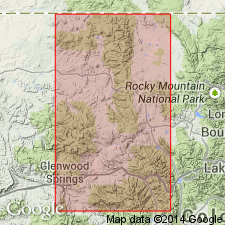
- Usage in publication:
-
- Yarmony limestone member
- Modifications:
-
- Original reference
- Dominant lithology:
-
- Limestone
- AAPG geologic province:
-
- Eagle basin
Summary:
Pg. 129, 130-131, 133. Yarmony limestone member of State Bridge formation. Essentially gray to brown sandy limestone. Thickness 2 to 10 feet. Thickest sections are in southwest part of area, and the lime generally thins to the northeast. Occurs about 140 feet above base of formation at type section and separates the formation into a "Lower" State Bridge formation and an "Upper" State Bridge formation. H.F. Donner, 1936 (Univ. Michigan unpub. PhD dissert.) [see also Donner, H.F., 1949, GSA Bull., v. 60, no. 8, p. 1215-1248] included this sandy limestone in his type section of the State Bridge but attached no particular significance to its presence. Fossils rare (casts). Age is considered Permian(?).
[Notable exposures on both sides of Yarmony Mountain north and northeast of State Bridge, McCoy area, Eagle Co., west-central CO (in area of State Bridge formation type).]
Source: US geologic names lexicon (USGS Bull. 1350, p. 840); supplemental information from GNU records (USGS DDS-6; Denver GNULEX).
For more information, please contact Nancy Stamm, Geologic Names Committee Secretary.
Asterisk (*) indicates published by U.S. Geological Survey authors.
"No current usage" (†) implies that a name has been abandoned or has fallen into disuse. Former usage and, if known, replacement name given in parentheses ( ).
Slash (/) indicates name conflicts with nomenclatural guidelines (CSN, 1933; ACSN, 1961, 1970; NACSN, 1983, 2005, 2021). May be explained within brackets ([ ]).

